Neptune
Inn clock, courtyard and interior
The Neptune Inn clock
A couple of pieces of hidden Neptune Inn history have been sent
in by Phil Snowden.

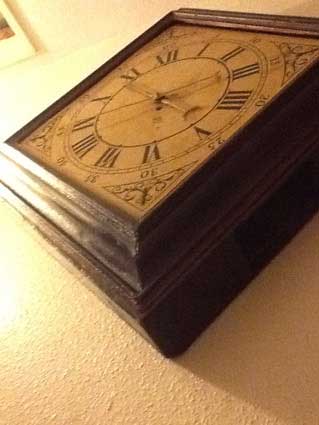
19.6.2014: “A few years ago I bought a clock which was thought
to be from the Neptune Inn, Ipswich. Measuring 41inches
across, it is enormous and heavy and only
the dial and surround part are left. It is on its
second movement which has scratched on it 'G.Adams for J.Haskell 1950'
who I believe are still in Tavern Street. When I took the movement out,
on the back of the wooden dial it says in capitals 'NEPTUNE INN'. The
original movement would have had a weight, so there would have been a
bottom part of the clock, probably with a maker's name on it, to let
the
weight drop lower without being tampered with, and to give a longer
running time. But the 50s movement is a fusee which has no weight. So
the bottom drop was removed and the hole for the weight filled in. I
would date this clock at about 1740. It would have been called a Tavern
Clock and I can imagine all those pirates viewing it whilst
on the lash. I love this clock and the look of the fabulous building it
was made for...
 All
photographs courtesy Phil Snowden
All
photographs courtesy Phil Snowden
... The 1950s replacement Victorian movement with all the
details of
who put it in for the shop in Tavern Street. The guy had to hack the
back of the dial out to fit it, and look at the pieces of thermometer
plate he used to fix it to the dial. The back of the dial has traces of
where a seat board was for the original movement to sit on. This is a
very unusual shape for a tavern clock but the case wood has been looked
at and it's early 18th century. Regards, Phil Snowden.”

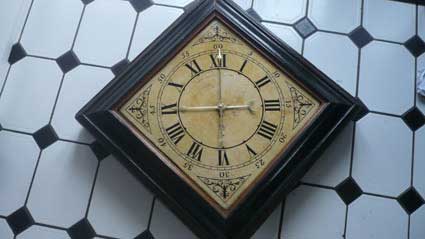
Neptune Antiques event
Phil also sends this undated photograph of the courtyard garden behind
the
Neptune, which we recall as Neptune Antiques which used to have open
days for potential customers. Perhaps this photograph is of such a
sunny day. Many thanks to Phil for his contributions.
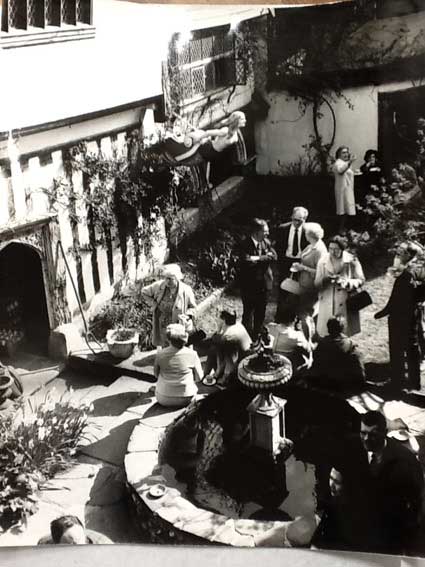
Interior and courtyard of The Old
Neptune Inn in summer 2016

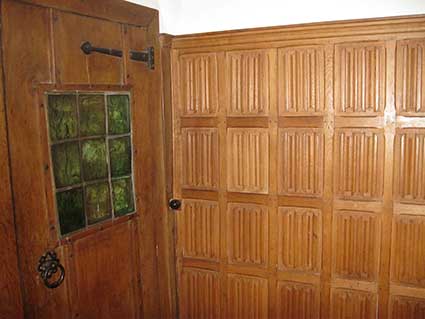 2016 images
2016 images
Above: large fireplace and linenfold panneling. Below: the main
entrnace hall
looking towards the rear courtyard from behind the front door;
also view down the staircase from the Galleon Room showing the porthole
window visible at the extreme left of the building frontage
on our Isaac Lord page.


The Galleon Bedroom: fonts in excelsis
'History. In the days when high water barges off-loaded the ground
floor from a now filled-in creek, this room was used as a counting
house. It was totally derelict until restored in the mid-1900s when the
room’s leaning walls were lined with 19th century wooden printer’s
blocks and the angled windows were restored to resemble those of
seafaring vessels of a bygone age.' (taken from the information sheet
in the room).
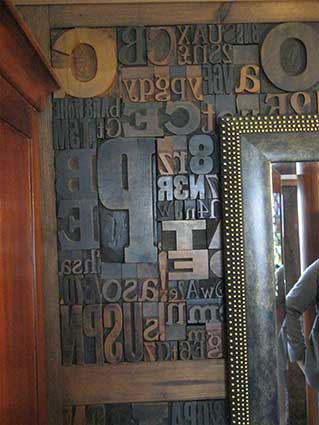





Well, this is
the Ipswich Historic Lettering website... when else are we going to get
such an opportunity?


Below: carved posts in the stair-wells.
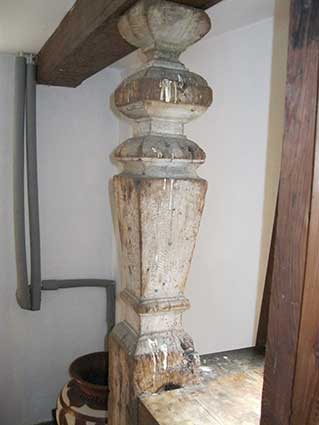



The courtyard garden. Below: the Galleon Bedroom wing with its
leaning walls. In the background the rear wall of the former John Good mill building, partially covered
with Virginia creeper, and the grey extension wall of the Salthouse
Harbour Hotel. The creek dug from the old Ipswich
dockside
(pre-Wet Dock in 1842) would have come through the John Good
site to
provide a private quay near the present courtyard.


Two heads in relief can be found at The Old Neptune including a
horned, fork-bearded, smiling satyr high on the gable and a grotesque
head set into the interior brickwork. It is likely that the latter
fragment was found elsewhere and built into the wall at a recent date.


Below stone arches (with lion heads on the keystones) form a
sort of cloister beside the courtyard; a timber dovecote has been built
into the weather-boarded gable. These features are shown in an
illustration in George Bodley Scott's self-published booklet
documenting his restoration of the site; not shown in the photographs
here, but still present is the ship's figurehead. The
1970 booklet can be downloaded on the Ipswich Society website (see Links) under the sub-sections Fore St
Facelift\History\Neptune.
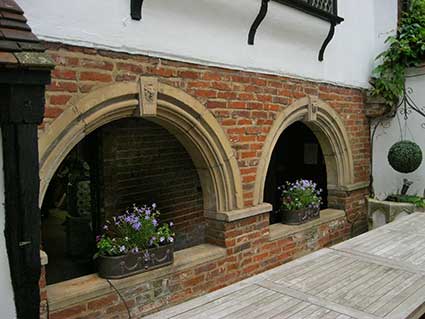

 Illustration by Clifford Southgate
Illustration by Clifford Southgate
George Bodley Scott
(1911-1977) was the Managing Director of W. S. Cowell Ltd, based in
Market Lane/Butter Market in the centre of the town and renowned in its
day for excellence in printing, reproduction, fine inks and papers.
Founded in 1818, the Ipswich firm of W. S. Cowell Ltd ('The Press in
the Butter Market') grew into one of the leading British printers,
known for its high-quality catalogue work.
The 15th/early 16th century merchant’s ‘hall house’ (the later Fore
Street frontage bear a date, '1639') had a chequered history up to 1947
when Scott purchased the dilapidated buildings and of the later
restoration, much of it carried out by the owner himself. In 2016, the
suite of buildings is hired out for accommodation and special occasions.
One tiny detail in the text is the account of an inlet from the river
was dug which came up to a quay beside the colonnaded open lower floor
on the east side of today’s courtyard. This would fit with the pattern
found at the Isaac Lord complex at 80 Fore Street, where a grand
merchant’s house fronting Fore Street was connected to warehouses and
maltings down to Wherry Quay. So loading and unloading of vessels and
carts, processing of raw materials, buying and selling and so on took
place under the gaze of the master. The John Good & Sons (GCB) Ltd,
British Oil & Cake Mills building blocks a view of the dock from
The Old Neptune. If the original merchant had his own quay (presumably
having a removable bridge on the quayside) he would not have needed
buildings right down to the water; or some other structures might have
stood there.
The Ipswich Society website (see Links)
features the Fore Street Facelift
1961 section which includes a page of information on The Old
Neptune in the 'History' section. Here you will be able
to download a PDF of the 1970 booklet about The Old Neptune published
by Bodley Scott and printed, of course, by Cowell's.
Return to Isaac Lord / Fore Street page.
Related pages:
The Question Mark
Christie's
warehouse
Bridge
Street
Burton Son & Sanders / Paul's
College Street
Coprolite
Street
Cranfield's
Flour Mill
Custom House
Trinity
House buoy
Edward
Fison Ltd
Ground-level dockside furniture
on: 'The
island', the northern quays
and Ransome's
Orwell Works
Ipswich
Whaling Station?
Neptune
Inn
clock, garden
and interior
Isaac
Lord 2
The Island
John Good and Sons
Merchant
seamen's memorial
The Mill
Nova Scotia
House
New Cut East
Quay
nameplates
R&W Paul malting
company
Ransomes
Steam
Packet Hotel
Stoke
Bridge(s)
Waterfront
Regeneration Scheme
Wolsey's
Gate
A chance to
compare
Wet Dock 1970s with 2004
Wet Dock maps
Davy's
illustration of the laying of the Wet Dock lock foundation stone,
1839
Outside
the Wet Dock
Maritime Ipswich
'82 festival
Home
Please email any comments
and contributions by clicking here.
Search Ipswich
Historic Lettering
©2004 Copyright
throughout the Ipswich
Historic Lettering site: Borin Van Loon
No reproduction of text or images without express
written permission


 All
photographs courtesy Phil Snowden
All
photographs courtesy Phil Snowden



 2016 images
2016 images



















 Illustration by Clifford Southgate
Illustration by Clifford Southgate